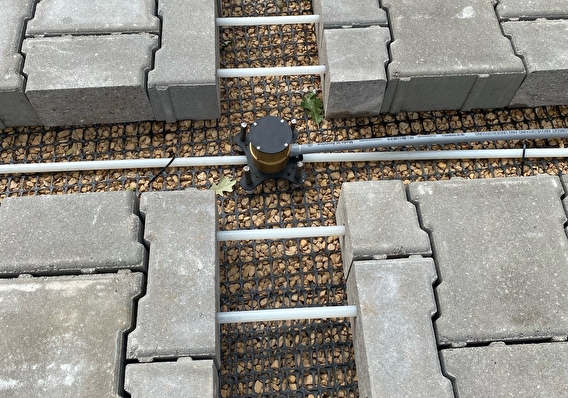
Heated pavement shows potential for controlling snow and ice while reducing reliance on salt. However, heated pavement systems are usually expensive and maintenance-intensive.
As part of the 2024 Salt Symposium, a panel of experts who have experience with heated pavement convened to discuss its pros and cons.
Pros of heated pavement
The three panelists agreed that the biggest upside to heated pavement is that it saves on salt, plowing, and snow management practices across the board.
Jeff Buch, PaveDrain sales manager, showcased his company’s heated pavement product as a means of reducing shoveling and salting needs. Buch explained that PaveDrain’s blocks are built with interlocking sides to eliminate the need for filler rocks in the seams, and then are manufactured with cable ducts through the block to run heated water piping straight through. This locates the pipes closer to the surface (which makes them more efficient at melting snow), and the open cracks between blocks allow meltwater to drain away and prevent ice dams.
Buch said the product can melt six inches of snow in eight hours starting at 22 degrees Fahrenheit.
Amy Hanson, fleet and facilities manager with the City of Plymouth, Minnesota, discussed the heated pavement system that was installed at the Plymouth Community Center in 2020. Through the winter of 2023–2024, Hanson said, the center saved around 650 pounds of salt, and the installation saved significant time for staff.
“Having 11,000 square feet of heated sidewalk where we didn’t have to take out equipment to clear snow and clear pathways is probably one of the biggest successes of the system,” she said.
Jeff Genova, downtown development coordinator with the City of Holland, Michigan, noted similar benefits on an even larger scale. Downtown Holland has the largest municipal snowmelt system in North America, Genova said. It encompasses 860,000 square feet of heated public sidewalks and streets (with an additional 190,000 square feet of privately owned heated pavement hooked up to the public system), all powered off waste heat from the city’s natural gas power plant.
Since the system was installed in 1989, it has significantly reduced plowing and salting efforts, which in turn reduces wear and tear on infrastructure, Genova said. It also negates problems with snowbanks, which are a visibility hazard for drivers, and it keeps downtown stores cleaner because salt is not tracked into buildings.
“We’re really proud of it,” Genova said. “It makes Holland a very vibrant downtown.”
Cons of heated pavement
The main drawback that the panelists noted was cost. The heated system in Holland, for instance, cost about $1.1 million to originally install, and Genova said that the city is still paying off transmission lines because the system is constantly being expanded. Transmission lines cost around $300 per square foot.
The energy cost, he said, is low for Holland (around $2,460 in February 2024, the city’s peak month) but the power plant it uses as a cheap heating source is located downtown—which is not always the case for other towns.
According to Buch, most heated pavement requires installation of a boiler. That’s the case for the Plymouth Community Center—and the system consumes a lot of energy and money, Hanson said. Heated pavement systems also tend to require a good deal of maintenance and finesse. The Plymouth Community Center, for instance, has an automated system that fires up when snow touches a snowmelt sensor embedded in the pavement—a feature meant to save on energy costs when the system isn’t needed. Hanson said that the system tends to be slow to start up and does not respond well to blown snow and ice.
For a PaveDrain network, any maintenance problems would necessitate digging up the section that potentially is affected to make repairs, Buch said. Traditional pavers can be individually pulled up and replaced.
Genova recommended installing systems with sectioned-off zones so they are easier to maintain piecemeal without disrupting an entire system at once.
The 2024 Salt Symposium was hosted online on August 6 and 7 by Bolton & Menk.
—Sophia Koch, contributing writer